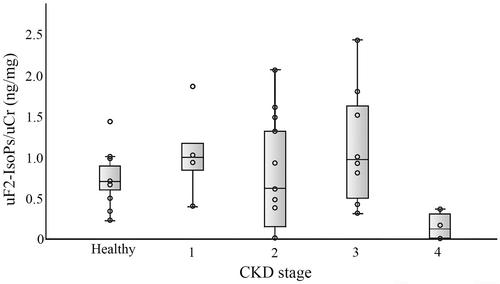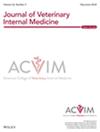Evaluation of oxidative stress in dogs and cats with chronic kidney disease
Abstract
Background
Oxidative stress is a potential contributor to chronic kidney disease (CKD) progression but has not been evaluated in dogs and cats with CKD.
Hypothesis
Oxidative stress is higher in animals with CKD compared with healthy controls and decreases with the advancing CKD stage. The aim of this study was to determine the presence and intensity of oxidative stress in dogs and cats at different CKD stages.
Animals
Sixty dogs and 30 cats with naturally acquired CKD; 10 dogs and 14 cats, healthy controls.
Methods
Analytical cross-sectional study. Oxidative stress was evaluated by measuring the urinary concentration of F2-isoprostane (uF2-IsoPs) normalized to urinary creatinine.
Results
Urinary F2-isoprostanes normalized to urinary creatinine of healthy dogs and of dogs with CKD Stages 1 to 4 was 3.3 ng/mg, 4.7 ng/mg (range, 1.0-73.4), 2.4 ng/mg (range, 0.4-7.8), 0.52 ng/mg (range, 0.01-2.9), and 0.37 ng/mg (range, 0.01-0.6), respectively. Urinary F2-isoprostanes differed among CKD stages (P < .001), but not compared with controls. uF2-IsoPs of healthy cats and cats with CKD Stages 1 to 4 was 0.68 ng/mg (range, 0.2-1.4), 0.97 ng/mg (range, 0.4-1.8), 0.6 ng/mg (range, 0.002-2.0), 0.94 ng/mg (range, 0.3-2.3), and 0.2 ng/mg (range, 0.01-0.4). Urinary F2-isoprostanes differed among stages (P = .05) but not compared with healthy controls.
Conclusion and Clinical Importance
Oxidative stress might be present in dogs and cats with CKD. Its magnitude declines as the disease progresses, therefore, it should be considered a potential therapeutic target mostly at the early stages of the disease.


 求助内容:
求助内容: 应助结果提醒方式:
应助结果提醒方式:


